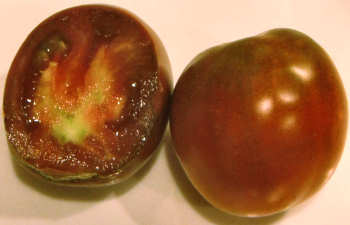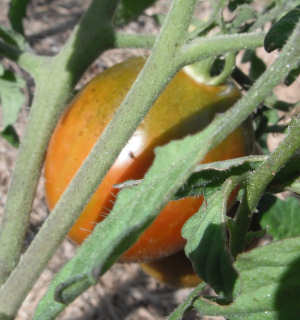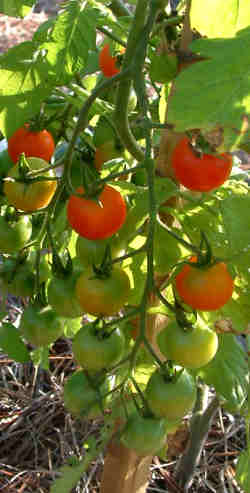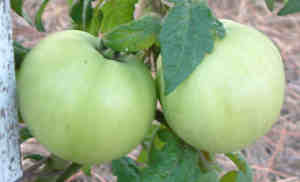Tomatoes in the Garden
Black Prince Tomato
The Black Prince tomato variety is a bit on the unusual side. First, it’s a very different shade — neither red nor black.
Next, it’s more of an oval shape, instead of round or beefsteak or even the standard “paste tomato” shape.
The picture you see here is one Black Prince tomato that’s pretty well ripe; you can see that it’s more of a mahogany color, rather than red or black.
The shape isn’t showing really well in this photo; it kind of looks like an oxheart shape, and it’s not.
The Black Prince variety is an heirloom tomato and comes to us from Russia, so it’s a fairly early tomato. In my Fall garden, it was the first to ripen fruits.
The plant itself is a little on the wimpy side, without a lot of leaves or stems. However, I have been impressed with the yield, which has been very nice indeed
How about a photo of one that’s still on the vine (albeit not quite ripe yet)?
This is in the sunshine, so the color is lighter, and once again, it’s not ripe. You might notice that it has “green shoulders” at the moment — the green mostly disappears as it gets fully ripe, but a greenish cast does remain.
Black Prince — Tomato Eating Time!
Here’s the big question…how does Black Prince taste?
I’m happy to say that the taste is very good. While some people say black tomatoes taste “smokey”, I didn’t find that to be true. Instead, it was a rich tomato taste – yum!
The flesh is a little soft, as with most varieties of black tomatoes, but reasonably firm nonetheless. There is a good mix of juice and flesh — not a dry tomato at all!
I’m glad that I grew Black Prince seeds in my Fall garden, and I look forward to a continued harvest, until frost (probably January for me).
Homegrown Tomatoes – 2010 Spring Garden
So it’s Spring 2010 and tomato plants are a growin’! I thought I’d make a video of a walk in part of my tomato garden, instead of just talking about it. Hope you enjoy!
And here’s the same garden, two weeks later!
SuperSweet 100 Cherry Tomatoes
SuperSweet 100 cherry tomatoes are fun to grow. And what’s really nice is that the cherry tomatoes they produce are nice and true to their name – sweet!
A Little About SuperSweet 100
This particular tomato is an improved variety over Sweet 100. And supposedly a relative of Sweet Million. It’s a hybrid tomato, so plants grown from the seeds won’t necessarily breed true. Although I do believe I will try it anyway! I’m curious to see what I’ll get next season.
The SuperSweet 100 plant in the photo (and you can click the photo for a larger picture) has the cherry tomatoes just starting to turn red. It will be interesting to look at when more of the fruits start ripening.
This particular plant is a survivor! It’s made it through nights in the 30’s, being nibbled on by rabbits and being blown down in high winds. It’s also not growing in the best part of the garden, so it’s got a lot going against it. But it doesn’t seem to matter; it keeps putting out flowers, and nearly every blossom sets fruit.
SuperSweet 100 is an indeterminate plant with regular leaves.
Growing Cherry Tomatoes
One nice thing about the SuperSweet 100 is that it’s a cherry tomato of a perfect size for your mouth, at about 3/4″ to about 1″ in size. I have mine growing in the ground, but I think they’d grow fine in a large container on the patio. For a true bounty, I’d use a 10-gallon container.
You will need to stake this plant. Mine is on a 5.5′ stake, which would probably also be OK for a container. If it was in the good part of the garden, I’d rather use a 7′ stake.
SuperSweet 100 is a fantastic “garden candy” — great for popping in your mouth while working in the garden. Actually, so far this season, none of the ripe fruits have made it to the table — I’ve munched them while out in the yard. Soon enough, though, there will be plenty to eat outside and bring into the house for salads.
Great Tomato Experiment, Revisited
I’ve had a bit of a setback on The Great Tomato Experiment; I ran into a stretch of bad weather, followed by what I think was possibly an overdose of potassium. As a result, all three plants are in sad, sad shape. In fact, so sad that I am starting over!
What Will I Do Differently?
First, is that I have come across some nice 17-gallon containers, and I’ll use them instead of the 10-gallons I had been using. I’ll sterilize and re-use the 10-gallons for some other tomatoes I have coming up for the summer (including two mystery tomatoes).
I’m going to add sphagnum peat moss and perlite to each of the containers. I’ve found the original mixture I used compacted a bit too much for my liking.
I’m going to add the main dose of fertilizer to the soil before planting, then mix it in well. I found with my raised bed tomatoes that when I did this, the plants grew more vigorously compared to the ones where I added the fertilizer as a side-dressing in the beginning.
Finally, I am using a different tomato variety. For some reason, Pineapple doesn’t seem to like my growing conditions (I have a 4th plant that I am growing in the ground in another part of the garden). It’s growing fairly well and putting forth tomatoes, but it’s not as vigorous as I would hope.
And the New Tomato Variety Is…
I have chosen Big Raspberry as the new tomato variety for The Great Tomato Experiment for the following reasons:
- Big Raspberry is a potato-leafed plant, and I find that tomato plants with potato leaves generally fare better in my garden.
- The tomatoes don’t generally get large (maybe 9 ounces), so if I can get a tomato of this variety over 1 lb using the giant tomato techniques, it will be an accomplishment.
- The plant is productive, but not necessarily tall. So if I can get the plant over 6 feet using the world record tomato techniques, it will be a visible accomplishment. Especially since I am growing it in a container!
- Finally, I’m choosing Big Raspberry because it’s an earlier tomato compared to Pineapple. Since it’s already April, I need to play catch-up before the worst of the South Florida summer heat arrives.
If you’re still wanting to experiment along with me and can’t locate Big Raspberry, a good second choice might be Prudens Purple. In fact, I would have used Pruden’s Purple as my first choice for this test if I hadn’t already had some growing in the garden. My other choice would be Caspian Pink.
So, I planted my seeds today. I planted 5 so I could choose the best 3 for the experiement. The other two…well, I’m sure I can find someone in my neighborhood who might like a couple of plants!
So, while the first part of the experiment failed, I still have an opportunity to continue. Onward!
Hybrid Tomatoes, Part 2
I talked about hybrid tomatoes in part 1 of this post. Now that we’ve discussed the cherry varieties, let’s talk about how the slicer-size hybrids are doing in the garden.
Hybrid Tomatoes in the Garden
Just as a review, I have the following slicer-sized hybrid tomato plants in the garden:
- Celebrity Bush (determinate slicer)
- Fabulous (determinate slicer)
- Goliath Bush (determinate slicer)
- Park’s Whopper (indeterminate slicer)
All these plants have there own merits, but so far, Fabulous has been, well, fabulous! It’s by far the most vigorous, and has a nice, healthy growth, and regular leaves. I have it growing in a 5-gallon container, and it behaves as if it were in the ground – very lush and full of blossoms.
There aren’t any ripe tomatoes yet on Fabulous (darn!), but I’m looking forward to them. If they taste even half as good as the plant currently looks, it’s earned a continued spot in my garden.
And how have the others fared?
Bush Goliath has been the most prolific to date, and the tomatoes from one of the plants has been fairly good; the other one’s taste has been forgettable. Both plants currently have ripening tomatoes, so we’ll see how this batch does. Bush Goliath is a fairly small plant in my garden, at just 16 inches tall, with rugose leaves.
Celebrity Bush has had a hard time with the cold weather this year. While it’s normally quite productive, this season’s chillier-than-usual winter has taken its toll. It has come back some, now that the warm weather is here to stay. I’ll keep an eye on it. This plant is about 12 inches tall at the moment, and has rugose leaves.
Park’s Whopper currently has the best tasting fruit of the group. The winter has been hard on it as well, but it’s coming back and producing some nice tomatoes. Had a great one on a sandwich yesterday! The plant is now at 12 inches tall (the February frost nearly did the plant in totally), and has regular leaves.



